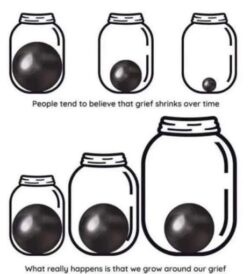 Sandplay therapy, which many people tend to think of as being solely for use with children, can be beneficial to people of all ages, and for all sorts of purposes. If you’re unfamiliar with the methodology, you should know that it is a gentle, effective way to heal the subconscious mind in a non-judgmental atmosphere, freeing you from old beliefs and roadblocks. This can apply to everything from relationships with friends and family, to career success, to a person’s relationship with food or money, all of which hinge on the messages and beliefs we absorbed from those around us before we could even speak.
Sandplay therapy, which many people tend to think of as being solely for use with children, can be beneficial to people of all ages, and for all sorts of purposes. If you’re unfamiliar with the methodology, you should know that it is a gentle, effective way to heal the subconscious mind in a non-judgmental atmosphere, freeing you from old beliefs and roadblocks. This can apply to everything from relationships with friends and family, to career success, to a person’s relationship with food or money, all of which hinge on the messages and beliefs we absorbed from those around us before we could even speak.
First pioneered by Margaret Lowenfeld, a child psychoanalyst, during the 1930s, sand and miniatures were incorporated into therapy quite by accident. The materials were present in Lowenfeld’s waiting room, and when she saw how the children she worked with were drawn to them, she brought them into her sessions. One of her students, Dora Kalff, refined the method, giving us the therapy as it is currently used.
The essence of sandplay is non-verbal and symbolic. In the presence of a trusted therapist, children and adults play with sand and water, along with a wide array of miniatures, representing everything from people to food, to create artistic representations of their inner world. The therapist holds the space for this exploration without offering commentary or interpretation, which allows the ego to let go of self-censorship over time.
Within this space of complete acceptance, the conscious and unconscious minds spontaneously bring themselves into harmony as the healing process progresses. During this healing, the ego strengthens and restructures itself, allowing for the release of inhibiting beliefs that can affect every aspect of a person’s life.
Typically, sandplay therapy is done alongside talk therapy, but the two are not intermixed, at least not through the prompting of the therapist, as this can actually slow down the healing process. Emotions that someone might normally consider to be shameful, such as rage, jealousy, or grief, can be expressed without fear when the person engaging in sandplay can trust that the therapist will not offer judgment, no matter how well-intentioned, through interpretation or suggestions for change, allowing for their full release.
Since no one leaves childhood unaffected by other people or our environment, sandplay therapy is appropriate for anyone and everyone. It might prove particularly effective if the idea of traditional therapy has been ineffective for you because you’re not sure where your issues are stemming from, or if you’re more interested in the healing than verbally exploring the causes of your psychological wounds.
Sandplay offers myriad benefits, and unlike the pharmaceuticals many people depend  upon to deal with buried issues, is free from side-effects. Most people find it to be both soothing and cathartic, making it a non-traumatic way to deal with the past. Every culture, from Native Americans to Tibetan Buddhists, has worked with sand in some healing capacity, giving it roots that stretch much further back in time than its modern, therapeutic form. Although it has evolved in significant ways, it has also withstood the test of time. Give it a try, and you might be surprised by the ways your inner child benefits by symbolically returning to the sandbox.
upon to deal with buried issues, is free from side-effects. Most people find it to be both soothing and cathartic, making it a non-traumatic way to deal with the past. Every culture, from Native Americans to Tibetan Buddhists, has worked with sand in some healing capacity, giving it roots that stretch much further back in time than its modern, therapeutic form. Although it has evolved in significant ways, it has also withstood the test of time. Give it a try, and you might be surprised by the ways your inner child benefits by symbolically returning to the sandbox.
Devon is a Licensed Mental Health/Substance Abuse Counselor, Personal Life Coach, Certified Personal Trainer, and a nationally certified teacher. She is committed to helping young people be their highest selves in all areas: body, mind, and spirit. Her expertise, enthusiasm, energy and educational background serve to create a unique blend of services and techniques employed to help you reach your goals. For counseling sessions, coaching, or training, please contact her at 505.469.0779 or he***************@***il.com.



